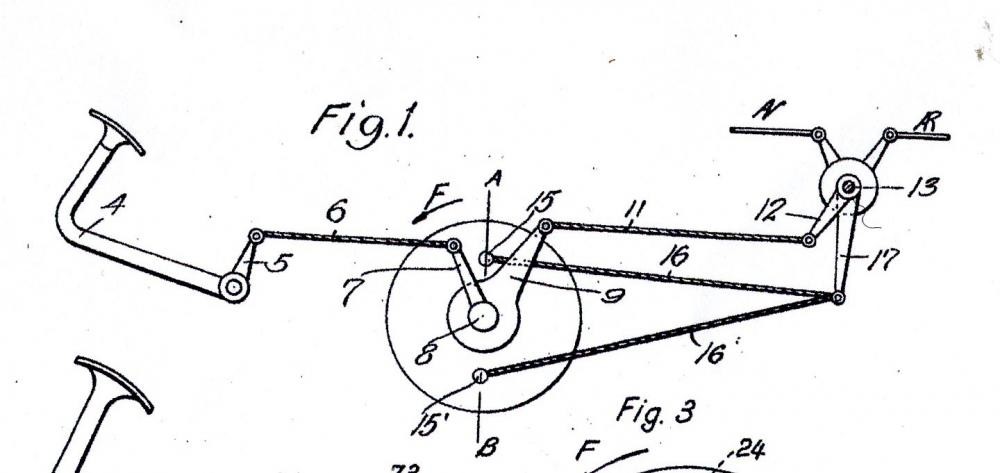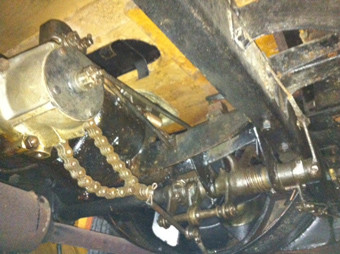You must be logged in to rate content!
7 minute(s) of a 217 minute read
1-20-2016
Hello Joe
Thank you for your interest, The PDF File that Spinneyhill has sent me covers the 1924 Patent application for the Renault servo in America. It covers in some detail how the servo works but unfortunately it does not give any actual drawings of the component parts of the servo. At least I now have a very clear explanation as to how it works.
I will not add the 5 pages of written explanation but if anyone really wants it if they send me a PM with their email address I will send the PDF file to them. It is written in English. One feature of the Renault servo is that it works when travelling forward or backwards and it is possible to apply the foot brake when the car is standing still.
Bj

Hello Roger
Happy New Year if somewhat belated. While you are enjoying some nice crisp winter days we are melting in 35-40 degree C days.
The only problem with the internet is that you can spend too much time on line and not out working on your project. Having said that, without some of the detail that has turned up on line this project would have bogged down months ago. I now know far more about my Renault than would have been possible even a few years ago.
Bj.
This is pure guesswork but I Imagine that Leon Saives was Louis Renaults agent working on his behalf in the USA. I cannot imagine Renault ever admitting that anyone but himself designed every part for all his cars.
Perhaps I am being too harsh on the man but he comes across as the original Control Freak.
I cannot imagine any competent engineer wishing to have his name associated with many of the "features" incorporated in Renault cars or things like the WW1 light tank which was designed to be so low as to be a minimum target for the emeny. The only problem was that the crew of two operated the thing whilst lying prone (on their stomachs?)
Bj.
1-23-2016
One of my good friends on the RAG Forum has sent me this photograph. This is exactly the servo that I am looking for. Now all I need to know is where I can find another one. Thank you Lucky.
Bj

1-24-2016
I now have the servo unit off my car and have a greater appreciation of both how it works and what is missing. Unfortunately among the missing parts are the drive pinion and almost all the clutch components plus the main two levers that activate the mechanisn and transmitt the braking power to the side to side, front to back, balance/compensation arrangement. I know that all that sounds vague but without the actual parts on the bench it is impossible to fully describe them. Neither of the hand books I have or anything I can find on the internet give either photographs or drawings.Where do I go from here? I am waiting patiently to see if Depanoto will answer my e-mail. In the meantime my friends on the RAG Forum may still turn up something.
Bj.
1-25-2016
Progress at last even if only one small hesitant step. My good friend Fossoyeur on the RAG Forum has sent me another 152 page spare parts catalogue in a PDF File. This one has a four page section devoted to the brake servo. As it is now 10.00pm Eastern Australian Summer time, I will wait until the morning to print out the relevant pages.
Bernie J
I have now had time to down load the PDF file, print out the relevant pages and scan the attached illustration of the servo unit. I have the main body (215550) and input shaft (215648) and end cap/bearing (215638) but I am missing the clutch along with the levers M & L and the clutch engaging screw mechanism N. Also missing is the main drive gear R. Probably the best (and only?) option is if I can find a complete unit. According to the most recent information on the RAG forum the servo brakes were much more widely used than I had first understod.
1928 Monasix (RY type) = no servo at all
1929 Monasix and Monastella (RY1 type) = both have the servo
1930 Monasix and Monastella (RY2 type) = only the Monastella has the servo.
This must make the odds on finding one much better. I understand that it is now winter in France and not the best time to go searching for bits outside (in the snow).Having said that at least I now know that all 9090 1929 Monasix/stella and 2797 1930 Monastella, a total of 11,887 cars that left the Renault factory were supplied with this servo unit. Surely they have not all been melted down for the aluminium case (215550).
Bj.

1-26-2016
With this number of cars produced between 1929 and 1931 even if the Germans had collected 75% of the then ten year old cars for scrap metal, there would still be about 300 left. OK the war ended in 1945, 71 years ago, but there should still be SOME bits left lying about in rural France. Just how I go about finding them is the question.
Probably a wanted advert in the l'Vie de la Auto and the Boncoin is the most likely to succeed the big problem is in placing adverts in either without being in France.
Bj.
1-29-2016
Well! I have had a relatively prompt reply from Depanoto and they are unable to assist in my search for a replacement for my incomplete brake servo. Certainly there are alternatives such as converting the brakes to hydraulic operation but that would be a major operation involving a major expense. Already I have spent far more than this car will ever be worth.
I don't expect anyone to tell me what I should do now.
I am disappointed that it has come to this but as far as I can see I may be able to sell the wheels and tyres for about a quarter of what they have cost me the rest may be worth a few dollars in scrap metal. In the one very expressive French word, MERDE!
Where to now?
Bj 198
1-30-2016
OK! OK! I have now finished cleaning the housing for the brake servo and cleaned and lubricated the two short pieces of (bicycle) chain. It is now all back together and re-attached to the side of the gearbox. All this has saved me an unknown number of dollars. Certainly hundreds; quite possibly thousands!
I have come up with a solution that even the Great, Louis Renault himself would be proud of.
The braking motion is taken from the pedal rearward via a short length of rod with a yoke at one end. One end of the chain is attached via the yoke and rod to an arm accached to the brake pedal cross-shaft from there the chain travels around a sprocket which is free to rotate on a short shaft within the servo housing. From there the chain travels through 180 degrees to energe from the servo housing directly below its other end but travelling in the opposite direction. From there the motion is taken via another short length of rod to the lever actuating the set of three bevel gears which act as a compensation arrangement betweeen the front and rear brakes the motion is then taken via a balance bar which acts to distribute the braking effort evenly between the right and left brakes. The braking effort is transmitted to the wheels via a series of cables running over pulleys to the front and rear of the car where the cables connect to the perrot shaft operating the brakes on each front wheel and a lever attached to the backing plates on each rear wheel.
Don't ask me if it works. With an advertised maximum speed of 59 kph (just over 30 mph) I doubt if that is all that important.
All together now. Three cheers of the late Lois Renault!
Bernie j.
This is so cool!
Posted by Diggymart on 3/26/20 @ 6:09:01 PM